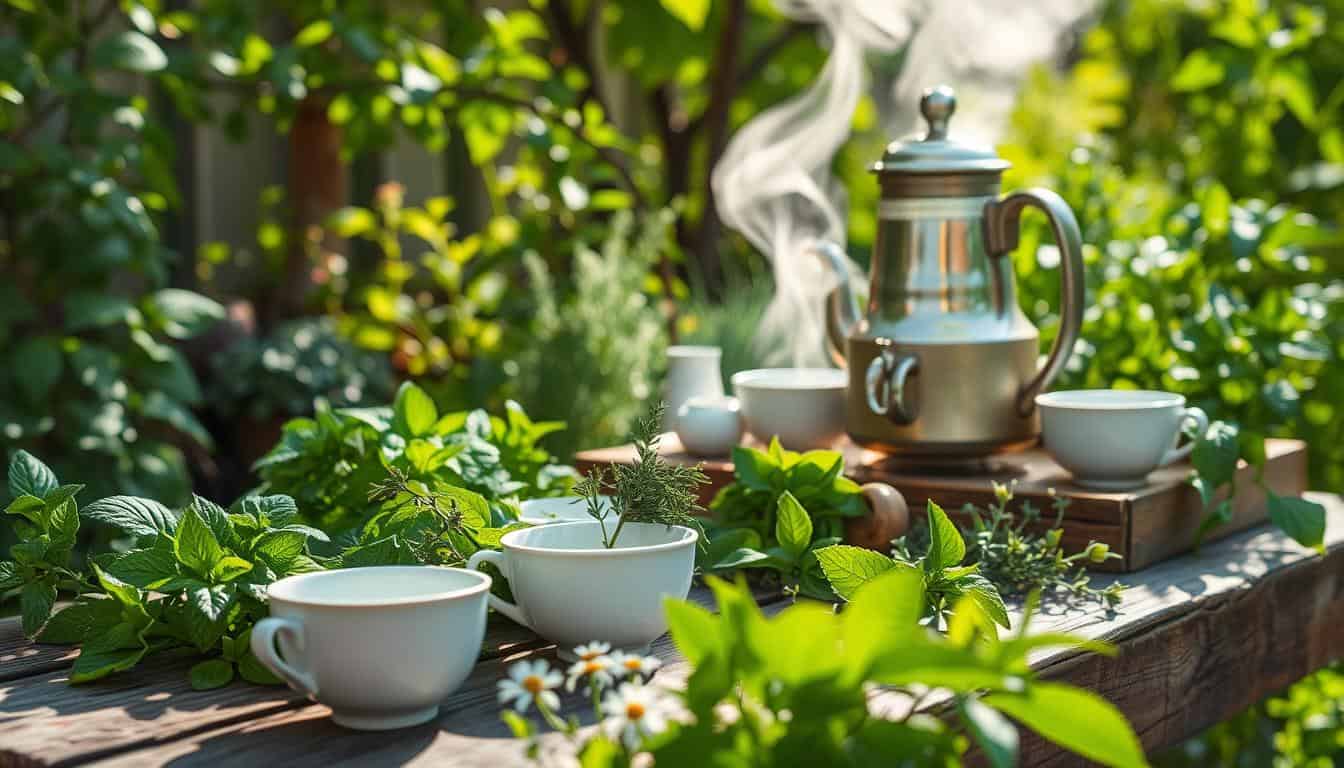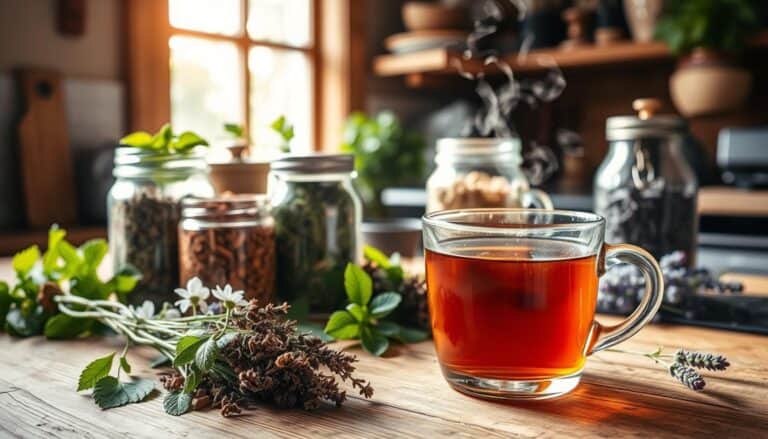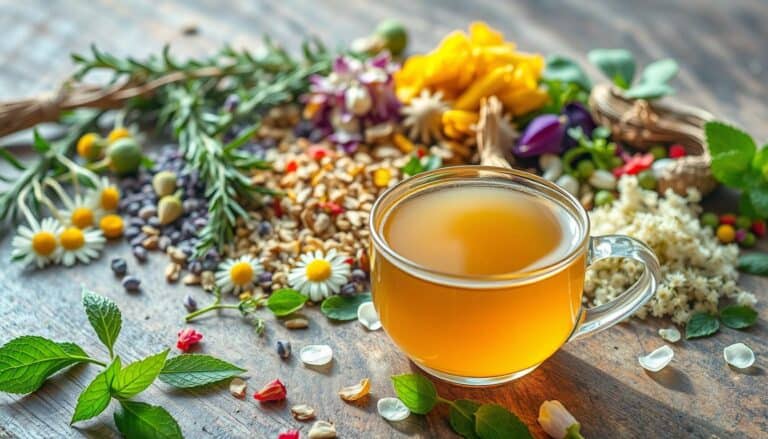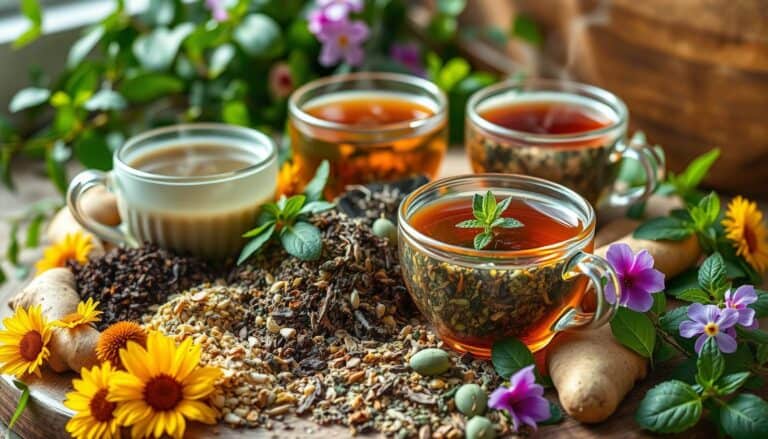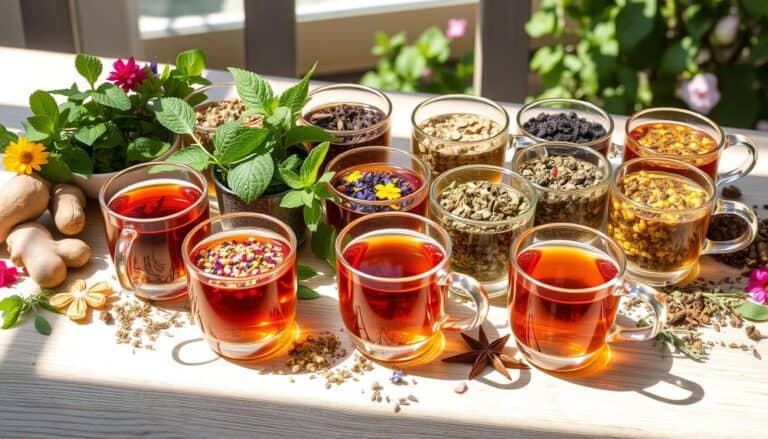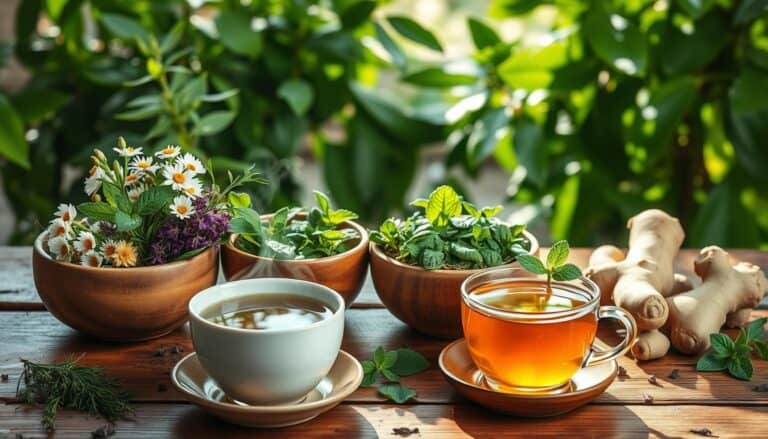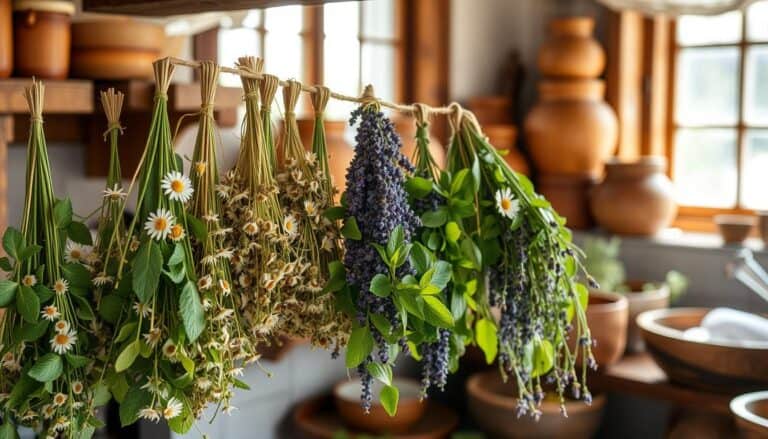15 Garden-to-Cup Herbal Tea Ideas
This post may contain affiliate links which means I may receive a commission for purchases made through links at no extra cost to you. I only recommend products I truly believe in. Thank you for your support!
Explore the enchanting world of garden-to-cup herbal tea. It’s where nature’s remedies meet creative cooking. Making your own tea from garden herbs turns them into nourishing drinks for body and soul.
Picture yourself in your garden, picking herbs, and making a warm cup of wellness. This journey links you with nature’s healing power. With a few easy steps, you can make your own herbal teas that are just as good as store-bought ones.
Starting your herbal tea journey means learning the basics of making tea. Tea experts say fresh herbs taste better and are more nutritious. By choosing organic herbs and learning how to infuse them, you’ll discover a world of tasty natural remedies in your backyard.
Your garden is full of herbs like mint, chamomile, lavender, and rosemary. Each one has its own special flavor and health benefits. The art of making garden-to-cup herbal tea is about trying new things, staying healthy, and connecting with old healing ways.
In this guide, we’ll show you how to turn your garden into a tea paradise. We’ll cover picking herbs, growing them, harvesting, and brewing tips to make your tea-making experience even better.
Introduction to Herbal Teas
Herbal teas open a world of natural wellness, blending flavor with health benefits. They use organic ingredients from gardens and wild places. Making herbal tea is more than just making a drink; it’s a way to care for your body and spirit.
Exploring Herbal Tea Benefits
Herbal teas do more than just quench thirst. They offer health support through their ingredients. Some benefits include:
- Enhanced digestive comfort
- Stress reduction and relaxation
- Immune system support
- Natural antioxidant intake
Essential Herbal Tea Ingredients to Discover
Creating great herbal tea starts with knowing the right organic ingredients. The most useful ones are:
- Leaves: Mint, lemon balm, and nettle
- Flowers: Chamomile, lavender, and hibiscus
- Roots: Ginger and echinacea
- Berries: Elderberry and rosehip
Tea experts say to use fresh herbs for better taste and health benefits. Use 1 teaspoon of dried herb or 2 tablespoons of fresh herb per cup of water.
By learning about herbal tea ingredients, you start a tasty journey of wellness and creativity.
Essential Herbs for Your Garden
Starting a garden for herbal tea is a fun journey into natural wellness. Garden herbs give you fresh ingredients for tasty and healing drinks. Each herb adds its own flavor and health benefits, making your tea time special.
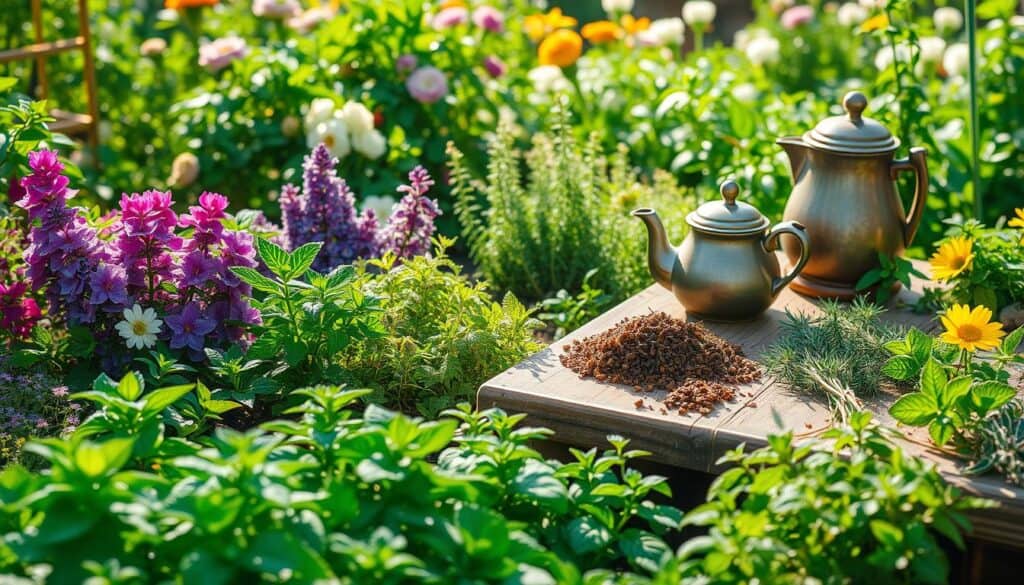
Mint Varieties: A Refreshing Garden Treasure
Mint is a great choice for those who love mint tea. Peppermint grows about 1 foot tall and loves lots of water and sunlight. Mint comes in many varieties, each with its own special taste:
- Peppermint: Sharp, cool flavor ideal for digestive support
- Spearmint: Milder taste, great for cooking and tea
- Chocolate mint: Unique dessert-like flavor profile
Lavender’s Aromatic Healing Powers
Lavender tea turns your garden into a fragrant haven. This elegant herb offers amazing aromatic benefits. Lavandula angustifolia makes soothing teas that help you relax and reduce stress.
Chamomile: Nature’s Calming Companion
Chamomile tea is a gentle herbal remedy. It grows up to 1.5 feet tall in full sun, with a light, apple-like taste. This delicate herb helps you sleep better and feel less anxious.
| Herb | Height | Sun Preference | Tea Benefits |
|---|---|---|---|
| Mint | 1 foot | Full sun | Digestive support |
| Lavender | 2-3 feet | Full sun | Stress reduction |
| Chamomile | 1.5 feet | Full sun | Sleep improvement |
Growing Your Herbs
Herb gardening opens a world of fresh, aromatic ingredients for homemade herbal teas. To grow a successful herb garden, you need to know the right growing conditions. This helps your plants thrive and produce the most flavorful leaves.
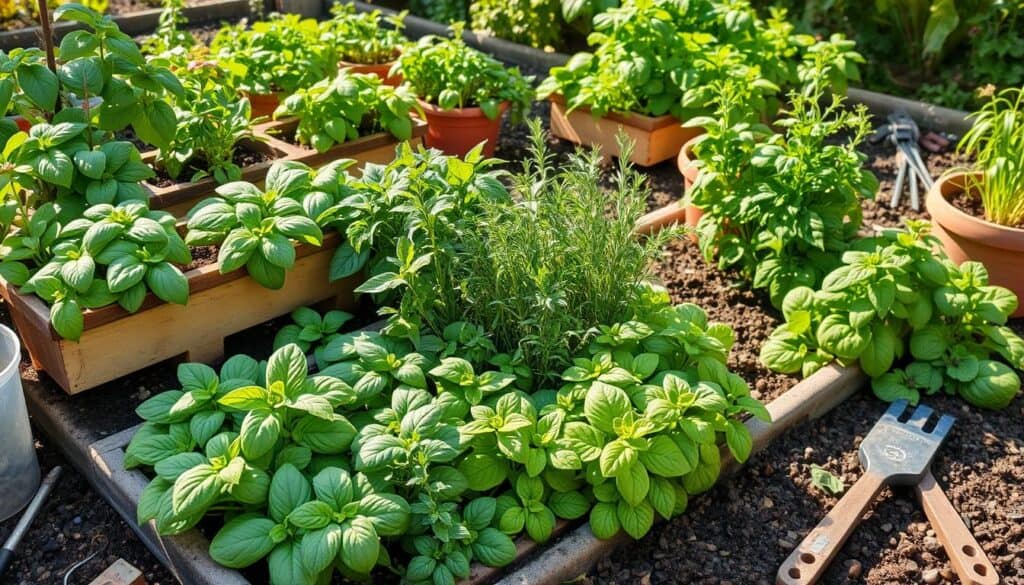
Best Practices for Herb Gardening
Starting a successful herb garden begins with picking the right spot. Each herb has its own needs. So, it’s important to plan carefully for a productive tea garden.
- Choose containers or garden beds with excellent drainage
- Select herbs compatible with your local climate
- Use organic soil amendments for better nutrition
- Prune regularly to encourage bushy growth
- Protect herbs from extreme temperature variations
Understanding Soil Requirements
Soil is key in herb gardening. Most herbs like well-draining, slightly alkaline soil with good organic content. Avoid heavy clay soils that retain too much moisture, which can cause root rot.
| Herb Type | Soil pH | Drainage Needs |
|---|---|---|
| Mint | 6.0-7.0 | High |
| Lavender | 6.5-8.0 | Excellent |
| Chamomile | 5.6-7.5 | Moderate |
Sunlight for Herbs: Essential Growing Conditions
Sunlight is vital for herb gardening. Most herbs need at least 6 hours of direct sunlight daily. Some, like mint, can handle partial shade. Others, like rosemary, need full sun.
- Full sun herbs: Rosemary, thyme, sage
- Partial shade tolerant: Mint, lemon balm
- Moderate light requirements: Parsley, chives
By following these basic herb gardening tips, you’ll have a garden that’s full of fresh, flavorful ingredients for your homemade herbal teas.
Harvesting Your Herbal Ingredients
Growing herbs for tea is an exciting journey from garden to cup. Knowing how to harvest herbs right ensures you get the most flavor. It also helps keep their valuable properties.

Timing Your Harvest for Peak Flavor
Harvesting herbs well needs careful timing. The best times to pick your garden treasures are:
- Morning hours after dew has evaporated
- Just before flowering stage for most herbs
- When leaves appear most vibrant and healthy
Effective Techniques for Drying Herbs
Keeping herbs fresh is key for tasty teas all year. Drying herbs right keeps their oils and flavors.
- Air-drying method: Hang herb bunches in a warm, dark space
- Oven-drying for quick preservation
- Using a food dehydrator for consistent results
When drying herbs, use clean scissors and cut stems carefully. Leave enough foliage for plant regrowth. Store your dried herbs in airtight containers in cool, dark places to keep their quality.
Storage and Preservation Tips
Properly preserving herbs lets you enjoy your garden’s bounty for months. Most dried herbs stay flavorful for up to a year. For the best results, label your containers with the harvest date and herb type.
Brewing the Perfect Herbal Tea
Making herbal tea is an art that mixes science and passion. It turns fresh herbs from your garden into tasty drinks full of flavor and health benefits.
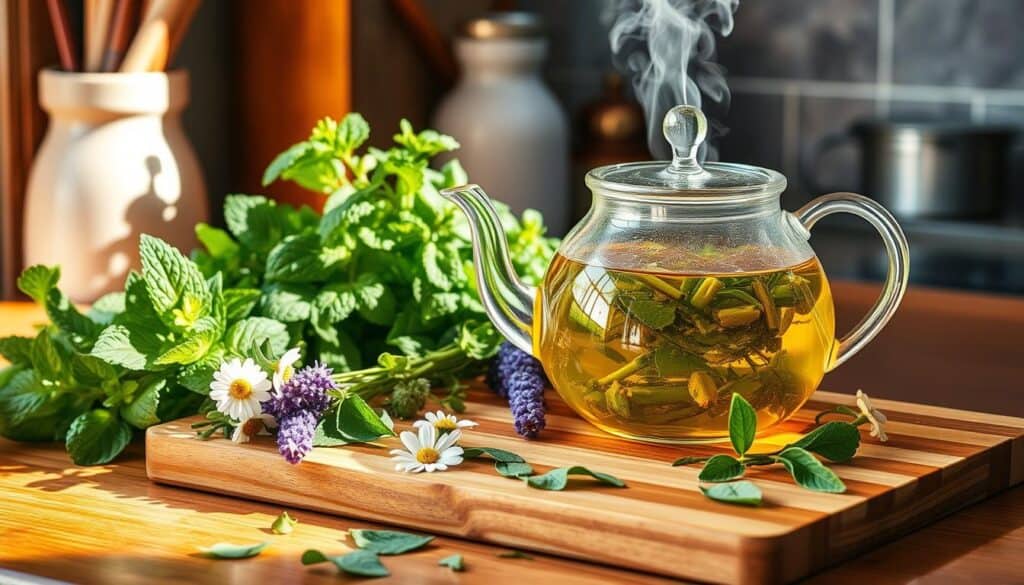
Knowing how to steep tea is key to getting the most flavor and health benefits from your herbs. Each herb needs a special way to brew to bring out its unique taste.
Essential Steps for Making Herbal Infusions
- Select fresh or dried herbs from your garden
- Measure herbs carefully: 1 teaspoon dried or 2 teaspoons fresh per cup
- Use boiling water at the right temperature
- Steep according to herb type and desired strength
Brewing Methods Explained
There are two main ways to make herbal tea: infusion and decoction. Each method is best for different herbs and results.
| Brewing Method | Herb Type | Steeping Time |
|---|---|---|
| Infusion | Leaves, Flowers | 5-10 minutes |
| Decoction | Roots, Bark, Seeds | 15-20 minutes |
Try different steeping times to find your favorite tea strength. Fresh herbs usually taste more vibrant. You can dry or freeze them to keep them for later.
Pro Tips for Perfect Herbal Infusions
- Use filtered water for best taste
- Cover your tea while steeping to retain essential oils
- Store dried herbs in airtight containers
- Consume within one year for optimal flavor
Creative Herbal Tea Recipes
Making herbal tea from your garden is fun and healthy. It’s all about blending herbs right to get the best taste and health benefits.
Getting the mix just right is key. Use 1 teaspoon of dried herbs or 2 teaspoons of fresh ones for each cup of water. Let it steep for 10 to 30 minutes to get the most flavor.
Refreshing Mint and Lemon Tea
Mint lemon tea is a refreshing pick-me-up. Mix fresh peppermint with lemon balm for a zesty drink. It’s great for your stomach and gives you a natural energy boost.
- Select young, tender mint leaves
- Harvest lemon balm in morning hours
- Use filtered water for brewing
- Steep for 15 minutes
Soothing Lavender Chamomile Tea
Lavender chamomile tea is perfect for unwinding at night. It helps you sleep better and lowers stress.
| Ingredient | Quantity | Benefit |
|---|---|---|
| Chamomile flowers | 2 teaspoons | Mild sedative effect |
| Lavender buds | 1 teaspoon | Stress reduction |
Unique Spiced Herbal Tea
Spiced herbal teas add warmth and health perks. Try ginger, cinnamon, or cardamom for unique flavors.
- Choose high-quality organic spices
- Blend complementary flavors
- Adjust ratios to personal taste
- Store dried herbs properly
Pro tip: Properly dried herbs can maintain quality for 1-2 years when stored in airtight containers away from direct sunlight.
Pairing Herbal Teas with Food
Enjoying herbal tea is more than just drinking it. Pairing it with food can turn a simple moment into a special treat. Learning about complementary flavors helps you find perfect matches that make both the tea and snacks taste better.
Perfect Snacks for Your Herbal Brews
Choosing the right snacks for your herbal tea can really enhance your experience. Each herbal tea has its own unique taste that goes well with different foods, leading to exciting flavor adventures.
- Chamomile tea pairs beautifully with:
- Light butter cookies
- Mild fresh cheeses
- Delicate almond pastries
- Mint tea matches perfectly with:
- Dark chocolate squares
- Fresh fruit platters
- Citrus-infused shortbread
- Lavender tea complements:
- Honey-glazed nuts
- Lemon pound cake
- Vanilla macarons
Flavor Combinations to Try
Trying new herbal tea snacks can lead to amazing discoveries. The trick is to find the right balance of flavors to create a perfect taste experience.
| Herbal Tea | Recommended Snack | Flavor Profile |
|---|---|---|
| Chamomile | Lavender shortbread | Soft, floral, delicate |
| Peppermint | Dark chocolate truffles | Cool, rich, refreshing |
| Lemon Verbena | Light goat cheese | Bright, tangy, smooth |
Finding your favorite tea and food pairings is a fun journey of taste discovery. Trust your palate and enjoy the process of finding unique complementary flavors.
Conclusion and Final Thoughts
Sustainable tea gardening turns your backyard into a lively spot for making drinks. Growing your own tea blends connects you directly to nature’s healing powers. Every herb you grow is a step towards a healthier, more mindful life.
Your herbal tea community grows with each new recipe you try. Whether it’s mint, chamomile, or sage, making your own tea is a rewarding journey. The joy of drinking tea made from your own herbs is unmatched.
Cultivating Connection Through Herbal Teas
Learning to dry and preserve herbs lets you enjoy them all year. By hanging herbs upside down and storing them right, you’ll always have tasty tea. Your green approach not only gives you great drinks but also cuts down on waste and helps local nature.
Sharing Your Tea Passion
Invite friends and family to see your herbal tea garden. Share your top blends, swap recipes, and encourage others to try it. As you keep trying new herb mixes, you’ll find new tastes and make memories that last.
